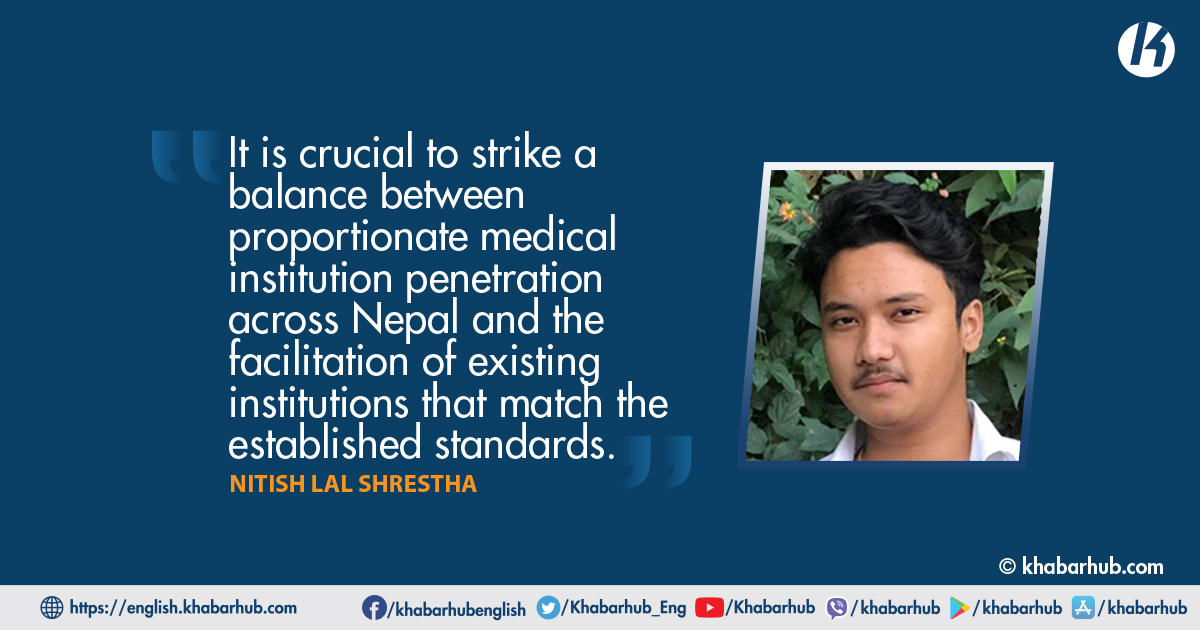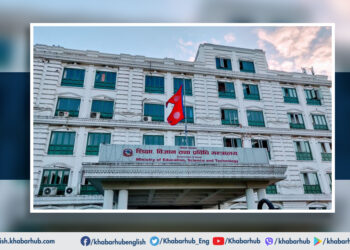One won’t be surprised to encounter debates concerning bringing down the number of seats in medical colleges in Nepal.
Limiting the seats in medical colleges in the country has been an issue of wide debate for quite a long time.
Tough competition owing to a limited number of seats in medical colleges in Nepal will compel students to quit their aspiration of pursuing medical studies in the country.
Appositely, citizens’ views are divided into two groups. While one section believes that limiting the number of medical seats is a good idea, the other argues that such restriction would result in an adverse situation.
This article will focus on the second group’s claim that it is not logical nor appropriate to apply the same restrictions to all medical colleges.
One of the key reasons for the government’s decision to reduce medical seats in Nepal is that the government claims that universities were enrolling more students than their infrastructure, facilities, and capability could accommodate.
This certainly does not look true and the view demonstrates a lack of research and comprehension, as several colleges can accommodate more medical students than the government allows.
Similarly, there is a strong demand for the establishment of private medical colleges in rural areas. Is it feasible to do so? Will students have access to all of the necessary facilities in such areas?
Due to seat limits, students qualified to study medical science who are also supported financially by their families are driven to study abroad.
Every year, thousands of medical students go overseas for their MBBS, even when their preference is to study in their native country.
In many ways, this is a huge economic loss for the country. These students would not have traveled abroad if medical seats in colleges were made available for enrolling additional students.
This would also allow a large amount of money to move into the Nepalese economy, benefiting the country as a whole. The average MBBS course fee per student is NRs. 50 lakhs.
Every year, if we multiply it by a thousand, we get NRs. 5 billion. This is the average fee that students in Nepal must pay.
Students studying for the same degree in another country must pay around $400 thousand in the United States and a similar amount in Europe.
The average fees of MBBS in Australia is AU$255,200 to AU$630,000 and US$200,000 in the United Kingdom.
Alongside, they must pay a large sum for airfare, as well as for stationery and hostel expenses.
Apart from the fee, if students were allowed to study here, there would be several daily expenditures that would recirculate in our economy.
Furthermore, it is a citizen’s right to study in their own country, and it is not fair for the government to limit seats and prevent citizens from studying in their home nation.
To summarize, a huge portion of the money is spent outside the country, money that could have helped Nepalese citizens and the country as a whole.
Not only are there economic considerations, but there are also social and psychological considerations.
‘Home will always be home, and no other place can compare to the calm and tranquility it provides.’ It is obvious that a person can concentrate better at home.
Students who fly abroad to study confront a variety of challenges, one of which is acclimating to their new surroundings.
If it were their home country, they would almost certainly make faster progress.
Similarly, when a person leaves home and travels overseas, they experience independence and a new comfortable living environment.
As a result, they will not return to their home nation. The money they spent on their education is gone forever, as is the education’s outcome. This is a huge loss for our society.
Furthermore, it is a citizen’s right to study in their own country, and it is not fair for the government to limit seats and prevent citizens from studying in their home nation.
Yes, the government should be accountable and set aside quotas for people who are financially challenged to pursue this degree.
Limiting the seats, on the other hand, would be unfair to those who want to study and are willing to pay all of their fees on their own.
Similarly, there is a strong demand for the establishment of private medical colleges in rural areas. Is it feasible to do so? Will students have access to all of the necessary facilities in such areas?
Can such hospitals be afforded by individuals living in remote areas? Will hospitals and medical schools thrive in rural areas? The answer is not obvious, complicated, and may not be feasible.
For instance, let us assume that the private sector establishes medical colleges in remote areas.
To add to the credibility, it is also a good idea to invite periodically external teams from other countries (third party review) for such quality assurance review.
Even though this is done, several challenges have to be addressed. It’s not just about the financial aspect here; in remote locations, medical colleges will lack resources and infrastructure, which will have a direct impact on medical students’ education.
Not only that but there will be a scarcity of medical experts and students willing to work or study in rural areas.
Similarly, it is even more important to undertake a need assessment before making such a demand. Hence, it will not be feasible to do so.
Even if the government establishes medical colleges and hospitals in remote areas, it will be difficult to sustain.
We can see the condition of Bir Hospital, which is one of the oldest in Kathmandu. We can contrast Bir hospital with Norvic hospital. Bir hospital was established much before Norvic hospital. In 1993 AD, the Norvic hospital opened as a health care and research center.
Today, Norvic has grown to become one of Nepal’s best hospitals, whereas Bir remains in a state of disarray. The situation of government-run hospitals demonstrates that building a medical school in rural areas would be unsustainable.
Hence, a lot of homework is required for this, and it is a long-term development process.
In our view, limiting seats in medical colleges arbitrarily does not make sense. The number of seats allowed in the medical colleges should be based on available quality assurance programs by reviewing and certifying the colleges on meeting the standards and requirements set by the country.
Opening medical colleges by the private sector should be encouraged. Some experts are of the view that the CRS money allocated by the companies could be allowed to open such schools and hospitals for the benefit of society.
The government should have an open policy and have a quality assurance program to ensure that those medical schools and hospitals meet the government requirements.
Where it is not running well, Government should consider running public medical colleges and hospitals on joint ventures by engaging with a reputed private sector.
Joint ventures should also be encouraged with foreign medical colleges and hospitals. Why are Nepalese going to India – Medanta, Appolo in India, and others in Bangkok and Singapore and not developing those skills in the country.
Need for specialized medical schools with hospitals is needed in the country. Let the developers decide where, how many, etc, and let them take the risks.
The government should have an open policy and have a quality assurance program to ensure that those medical schools and hospitals meet the government requirements.
To add to the credibility, it is also a good idea to invite periodically external teams from other countries (third party review) for such quality assurance review.
Therefore, it is crucial to strike a balance between proportionate medical institution penetration across Nepal and the facilitation of existing institutions that match the established standards.









Comment